Breakthrough in Muscle Regeneration: Identifying the 'Control Center' to Improve Elderly Muscle Healing

A groundbreaking study reveals a cellular 'control center' in muscle tissue that could revolutionize treatments for age-related muscle loss and improve healing in the elderly through new cellular communication pathways.
Researchers from Aarhus University and Steno Diabetes Center Aarhus have uncovered a critical cellular communication pathway involved in muscle repair. When muscles sustain injuries, a complex regeneration process begins, involving the removal of damaged tissue and rebuilding of muscle fibers. This process requires precise coordination among various cell types, particularly fibro-adipogenic progenitors (FAPs) and immune cells like macrophages.
In a recent study published in Nature Communications, scientists identified a novel form of cellular communication that plays a central role in muscle healing. FAPs, specialized cells residing within muscle tissue, act as coordinators, facilitating communication with immune cells to support effective regeneration. Specifically, FAPs produce the complement C3 protein locally within the muscle, a significant finding since previous theories suggested this protein was produced exclusively by the liver and circulated in the blood.
This local production of complement C3 appears to regulate inflammation—a vital step in muscle repair. The discovery opens new therapeutic avenues, especially for elderly individuals and those suffering from muscle-wasting conditions due to chronic inflammation. By targeting FAPs and their signaling mechanisms, it may be possible to improve muscle regeneration and counteract age-related muscle loss.
"Our findings highlight the importance of intercellular communication for muscle healing, and suggest that modulating these pathways could help treat muscle degeneration in aging and disease," explains Associate Professor Jean Farup. The next phase of research will explore how this mechanism functions in chronic inflammation and related diseases such as diabetes and cardiovascular conditions.
This breakthrough enhances our understanding of muscle repair processes and offers hope for developing targeted treatments that can enhance recovery and muscle health in vulnerable populations.
Stay Updated with Mia's Feed
Get the latest health & wellness insights delivered straight to your inbox.
Related Articles
Availability of Updated COVID-19 Vaccines Varies by State in 2025
Several U.S. states are expanding access to the updated COVID-19 vaccines in 2025, ensuring broader availability amid federal regulatory challenges and changing recommendations.
Stem Cell Grafts Show Promise in Restoring Myelin in Progressive Multiple Sclerosis Animal Models
Recent research indicates that neural stem cell grafts can successfully promote remyelination in mice with models of progressive multiple sclerosis, opening new avenues for regenerative treatments in MS patients.
India Raises Health Alarm Due to Rising Cases of Brain-Eating Amoeba
India reports a surge in brain-eating amoeba cases, with increasing infections and fatalities highlighting urgent public health concerns. Learn more about Naegleria fowleri and its risks.
Study Finds Breastfeeding Offers Long-Term Cardiac Benefits for Mothers
Breastfeeding, especially for women with gestational diabetes, is linked to reduced long-term risk of heart disease, according to a recent study. Learn how postpartum breastfeeding supports maternal heart health over decades.



